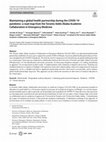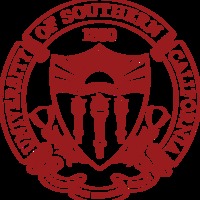Papers by TEMESGEN MENGISTIE BEYENE
African Journal of Emergency Medicine
Ethiopian journal of health sciences, Sep 1, 2022
Ethiopian journal of health sciences, May 1, 2022

Nursing Practice Today
Background & Aim: The Glasgow Coma Scale is a helpful instrument for measuring patients’ level of... more Background & Aim: The Glasgow Coma Scale is a helpful instrument for measuring patients’ level of consciousness with neurosurgical disorders. Literature showed a majority of nurses don’t believe the Glasgow Coma Scale assessment is their area of practice. This study aimed to examine the Glasgow Coma Scale assessment practice and associated factors among nurses working in adult intensive care units of federally administered hospitals Methods & Materials: : Institutional-based cross-sectional study was conducted on conventionally selected 126 nurses working in adult intensive care units. Six clinical scenarios were used to assess practice, and those who correctly answered at least four scenario questions out of 6 practical scenario questions for the Glasgow Coma Scale assessment were considered good practice. Data was collected using a self-administered questionnaire. The Chi-square test was applied to examine the variables affecting Glasgow Coma Scale practice. Furthermore, the propo...
Bahir Dar University Journal of Law, Dec 1, 2012
This article sets out to evaluate whether the Ethiopian constitutional adjudicator meets standard... more This article sets out to evaluate whether the Ethiopian constitutional adjudicator meets standards of independence and impartiality to handle constitutional adjudicatory role. It assesses the institutional organization of the constitutional adjudicator, and how and by whom its members are elected or appointed. It considers the various elements and aspects of independence and impartiality and the factors that affect each one of them. To make a meticulous assessment of the Ethiopian constitutional adjudicator in light of those internationally accepted standards, the Article undertakes a comparative analysis with the constitutional adjudicators of two other jurisdictions, Germany and South Africa. It identifies weak sides of the Ethiopian constitutional adjudicator. Finally the Article draws conclusions.

Bale Mountains of Ethiopia are part of the Eastern Afromontane and Afroalpine Biodiversity Hotspo... more Bale Mountains of Ethiopia are part of the Eastern Afromontane and Afroalpine Biodiversity Hotspot, one of the 34 Conservation International Biodiversity Hotspots. These Mountains are the source of 40 rivers and streams contributing to five major rivers where about 12 million people are downstream users. For long time, Bale Mountain massifs are designated as Bale Mountains National Park (BMNP). Recurrent and extended forest fire however is becoming a tragic challenge for sustainable management of the biodiversity and endemism it harbours. We investigated the scope, causes and consequences of the 2008 forest fire in the BMNP in particular, and history of fire incidences in the whole Bale Mountains massifs in general. Data was gathered using literature review, transect walk, semistructured interviews, group discussions, GPS and accusation of pictures. Fifty systematically and randomly selected informants were participated in the study. Soft wares like SPSS and arch GIS were employed in data analysis. Results showed that forest fire in the Bale Mountains is likely a common phenomenon during the last few decades, but with increasing severity in recent years. According to the last 30 years data, the scope of fires increased from 210 ha to 12,825 ha. About 84% of the recent fires were happened within the BMNP, burnt 60% of the "Ericaceous belt", the major water catchment area of the Bale Mountains massif. Most fires were human induced. A declining water percolation, increasing runoff, rivers pollution, death and migration of wild life, burnt soil up to 15 cm depth, shrinking forest size were mentioned as major consequences. A continued forest fire may lead to the devastation of the entire hot spot, signifying the urgent need to design an integrated forest fire management plan which seems non-existent in the country.

Canadian Journal of Emergency Medicine, 2021
The Toronto Addis Ababa Academic Collaboration in Emergency Medicine (TAAAC-EM) is an educational... more The Toronto Addis Ababa Academic Collaboration in Emergency Medicine (TAAAC-EM) is an educational global health partnership established 10 years ago to support the growth of EM in Ethiopia. In-person global health partnership activities were disrupted by the COVID-19 pandemic. We describe our five-step process for transitioning our global health partnership to a virtual space. Each step was conducted in collaboration between the University of Toronto and Addis Ababa University EM physicians: (1) risk identification and needs assessment, (2) discussing mitigation strategies, (3) crafting and piloting an approach, (4) revising based on pilot results, 5) implementation with continuous evaluation and revision. Teaching was modified iteratively in response to feedback. Our experience shows that virtual teaching, while not a replacement for in-person engagement, can be a valuable tool both to supplement partnership activities when travel is not possible, and to enhance global health partnerships long term. This approach can also inform the transition of other forms of medical education to the virtual space.

Sinet, Ethiopian Journal of Science, 2020
Maize (Zea mays L.) is grown popularly in the world. It is severely attacked by termites. Insecti... more Maize (Zea mays L.) is grown popularly in the world. It is severely attacked by termites. Insecticides are widely used to control, but could not minimize termites’ damage mainly because of resistance development and easily break down of the active ingredients. Hence, field experiment was conducted with the aim of evaluating different botanical crude extracts from leaves of Croton macrostachys (Hochst), Jatropha curcas L. and Phytolacca dodecandra L. for the management of termites. The experiment was conducted at Wollega University (wu) under irrigation and rain fed conditions. Leaves of the botanicals were collected from experimental sites in western Ethiopia and dried under shade. The dried leaves were grounded to a fine powder using a small hand-operated manual grinder and the powder was further sliced with analytical mill and sieved through a 0.25 mm pore size mesh to make uniform fine dust particle. The treatments were C. macrostachys, P. dodecandra, J. curcas, C. macrostachys ...

JAC-Antimicrobial Resistance, 2020
Background Hospital-associated infection (HAI) and antimicrobial resistance (AMR) are major healt... more Background Hospital-associated infection (HAI) and antimicrobial resistance (AMR) are major health threats in low- and middle-income countries (LMICs). Because diagnostic capacity is lacking throughout most of Africa, patients are commonly managed with prolonged empirical antibiotic therapy. Our goal was to assess mortality in relation to HAI and empirical therapy in Ethiopia’s largest referral hospital. Methods Cohort study of patients with suspected HAI at Tikur Anbessa Specialized Hospital from October 2016 to October 2018. Blood culture testing was performed on an automated platform. Primary outcomes were proportion of patients with bloodstream infection (BSI), antibiotic resistance patterns and 14 day mortality. We also assessed days of therapy (DOT) pre- and post-blood culture testing. Results Of 978 enrolled patients, 777 had blood culture testing; 237 (30%) had a BSI. Enterobacteriaceae were isolated in 49%; 81% of these were cephalosporin resistant and 23% were also carbape...
Frontiers in Public Health, 2020
Conclusions: A pharmacist-led AMS intervention focused on duration of antibiotic treatment was fe... more Conclusions: A pharmacist-led AMS intervention focused on duration of antibiotic treatment was feasible and had good acceptability in our setting. Cessation of audit-feedback activities was associated with immediate and sustained increases in antibiotic consumption reflecting a rapid return to baseline (pre-intervention) prescribing practices, and worse clinical outcomes (increased length of stay and in-hospital mortality). Pharmacist-led audit-feedback activities can effectively reduce antimicrobial consumption and result in better-quality care, but require organizational leadership's commitment for sustainable benefits.

Journal of Biology, Agriculture and Healthcare, Mar 1, 2020
This study is aimed to assess farmers' perception of termite infestation and their indigenous man... more This study is aimed to assess farmers' perception of termite infestation and their indigenous management practices in Abedengoro resettlement areas. Four termite hot spot rural resettled kebeles (lower Ethiopian administrative units) were selected purposively to include highly termite infested areas. Questionnaires were used to collect data from 240 respondents which account 3.5% of the total population those selected proportionally from the sample kebeles. Descriptive statistics was used to analyze the collected data. The results show that the local farmers' perception about termite infestation was very high. They reported that termites mostly damage crops, forest trees, and grazing land. However, the damage is serious to annual and biennial plants. Maize, sorghum and teff were reported to be the most infested crops among the crops produced in the study settings. The farmers also reported that termites that pose damage are prevalent year-round, but abundantly found in dry season. The farmers in study area knew termite infestation problems and indigenous management practices. Among the indigenous termite management practices reported, disturbing mound and suffocating mound with flood were the major indigenous termite management practices identified in the study setting. In conclusion, utilization of farmers' indigenous knowledge will not only promote ownership and sustainable use of intervention tools against termite pests but also has paramount importance in complementing ecologically friendly methods of termite control in an Integrated Termite Management in rural Ethiopia.

Emergency Medicine International, 2020
Background. Electrocardiography (ECG) is the graphical display of electrical potential difference... more Background. Electrocardiography (ECG) is the graphical display of electrical potential differences of an electric field originating in the heart. Interpretation of ECG is a core clinical skill in the department of emergency medicine. The main aim of this survey was to assess competency of ECG interpretation among 2018 graduating class medical students in Addis Ababa University and Haramaya University. Methodology. A cross-sectional survey was conducted on medical interns at Addis Ababa University and Haramaya University. Data had been collected from October 01, 2018, to October 30, 2018, by using structured questionnaires. Data were entered, cleaned, edited, and analyzed by using SPSS version 25.0 statistical software. Descriptive statistics, cross-tabs, chi-squared test, Mann–Whitney U test, and binary logistic regression were utilized. Results. Two-hundred and two graduating medical students were involved on this survey, out of which 61.3% (95% CI 56.3–66.3%) and 32.75% (95% CI 28...

CJEM, 2019
ABSTRACTObjectivesPodcasts are increasingly being used for medical education. A deeper understand... more ABSTRACTObjectivesPodcasts are increasingly being used for medical education. A deeper understanding of usage patterns would inform both producers and researchers of medical podcasts. We aimed to determine how and why podcasts are used by emergency medicine and critical care clinicians.MethodsAn international interprofessional sample (medical students, residents, physicians, nurses, physician assistants, and paramedics) was recruited through direct contact and a multimodal social media (Twitter and Facebook) campaign. Each participant completed a survey outlining how and why they utilize medical podcasts. Recruitment materials included an infographic and study website.Results390 participants from 33 countries and 4 professions (medicine, nursing, paramedicine, physician assistant) completed the survey. Participants most frequently listened to medical podcasts to review new literature (75.8%), learn core material (75.1%), and refresh memory (71.8%). The majority (62.6%) were aware of...

Public Health Action, 2019
Setting: Nineteen health facilities in rural, southeastern Malawi.Objective: To describe the impl... more Setting: Nineteen health facilities in rural, southeastern Malawi.Objective: To describe the implementation and results of a 6-week intervention to accelerate human immunodeficiency virus (HIV) case finding.Design: Six HIV testing strategies were simultaneously implemented. Routinely collected data from Ministry of Health registers were used to determine the number of HIV tests performed and of new cases identified. The weekly averages of the total number of tests and new cases before and during the intervention were compared. Testing by age group and sex was described. The percentage yield of new cases was compared by testing strategy.Results: Of 29 703 HIV tests conducted, 1106 (3.7%) were positive. Of the total number of persons tested, 69.5% were women and 75.5% were aged >15 years. The yield of positive test results was 3.5% among women, 4.3% among men, 4.4% among those aged >15 years and 1.5% among those aged 15 years. The average weekly number of tests increased 106.7% ...

Beijing Law Review, 2019
After the downfall of the Socialist and military Siad Barre regime in Somalia, Somaliland took an... more After the downfall of the Socialist and military Siad Barre regime in Somalia, Somaliland took an immediate action of independent declaration of statehood from its failed "parental state", Somalia. It has been almost twenty five years since Somaliland declared its independence, established its own government, kept the peace, and managed to flourish in a kind of stability. Nevertheless, the international community has not recognized its act. Among the former Somali Republic territories, it is now only Somaliland that secured democratic and stable government and sustainable peace in the region. Somalia, which was part and "heir" of the former Somali Republic, is now unstable and even challenged by the Islamist extremist group, Al-Shabab. Somaliland, once under the colonial power of the British Empire like other African countries, argues it should be recognized as an independent state. This article investigates the legal understandings of statehood, from the Montevideo Convention to the more recent emphasis on self-determination, and then turns to the case of Somaliland, arguing that Somaliland deserves statehood status and other states should recognize it as a state as there is no legal ground under international law that justifies an otherwise position.
African Journal of Emergency Medicine, 2017











Uploads
Papers by TEMESGEN MENGISTIE BEYENE